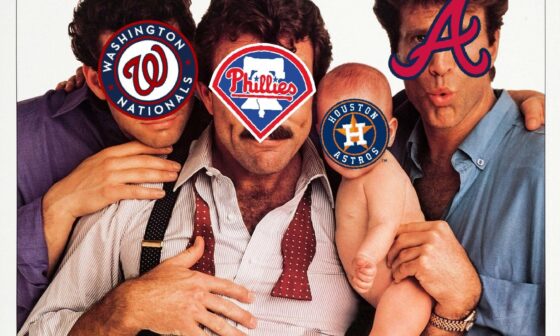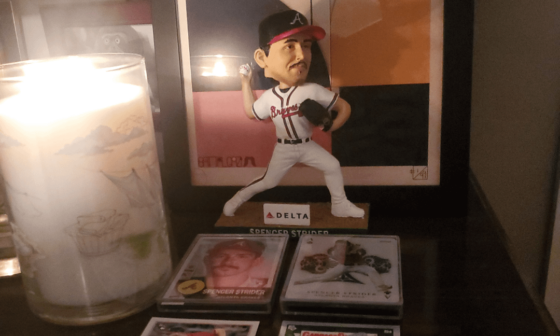
We’ve all seen that OAA thinks Ronnie is quite bad in RF, but I think less clear is what exactly OAA encompasses and why it thinks he’s well below average in the field. I thought I’d break it down a little bit.
First of all, it **doesn’t consider his assists at all**. We don’t really know how to give credit for outfield assists, since we don’t really have a big sample to identify what an average fielder would do in that situation nor do we know how much credit to give the baserunning team for overextending, etc etc etc. Ronald has the strongest arm in baseball per Statcast, and I suspect he’s producing a decent amount of value by both getting runners out and by dissuading runners from trying to take home. That said, it’s likely that the components OAA *does* measure are far more significant, for the simple reason that they’re over an order of magnitude greater in number.
So how does OAA work for outfielders? It’s pretty simple, actually. Statcast measures exactly where Ronald is standing on the field. Then, it looks at two factors: 1) how far from Ronald is the ball going to land? and 2) how long is the ball going to hang in the air for? The further away and the shorter the hang time, the harder the play. Every combination of hang time and distance is given a catch probability based on what percentage of the time fielders around baseball make that play, and that determines your OAA on the play. If there’s a 50% catch probability, you’ll be assessed +0.500 OAA for making the play and -0.500 OAA for letting the ball drop. On an 80% catch probability, it’s +0.200 for a catch and -0.800 for a miss, and so on.
For those that are interested in the catch probability chart itself, here’s the table: [https://baseballsavant.mlb.com/statcast\_catch\_probability](https://baseballsavant.mlb.com/statcast_catch_probability)
You can look there to find exactly what the catch probability is for any combination of hang time and distance required.
Now, on to Ronald in particular. His catch graph looks like this:
​
[Lots of Dots](https://preview.redd.it/7996icwtvuua1.png?width=750&format=png&auto=webp&v=enabled&s=583094645e8182a9048d77581679bc0f3e8093f9)
Up and to the left means the play is easy, down and to the right means hard. The five colored bands are the interesting part here: anything to the upper left of them has a >95% catch probability and anything to the lower right of them has a 0% catch probability. It’s within those five bands that fielders produce all their positive (and negative) value. Here’s what they represent, from top to bottom:
1 star catch: 91-95% catch probability
2 star catch: 76-90% catch probability
3 star catch: 51-75% catch probability
4 star catch: 26-50% catch probability
5 star catch: 1-25% catch probability
Looking at Ronald’s chart, the problem becomes a bit obvious: he’s not really making any difficult catches at all, and despite making all of the easy plays consistently, it starts to add up. Let’s check out some examples of what this looks like in practice:
[https://baseballsavant.mlb.com/sporty-videos?playId=c537cd05-d4c9-4b29-bff1-b7ebb9473c2c](https://baseballsavant.mlb.com/sporty-videos?playId=c537cd05-d4c9-4b29-bff1-b7ebb9473c2c)
Here’s a Nelson Cruz double. It’s a difficult play, with a catch probability of 35%. Ronald is slow off the jump, though, and the result is that it looks out of reach. Fielders track that ball down 35% of the time, though, so he’s assessed -0.350 OAA for it.
[https://baseballsavant.mlb.com/sporty-videos?playId=60e19866-1a58-40dc-bacb-e5747c4430f4](https://baseballsavant.mlb.com/sporty-videos?playId=60e19866-1a58-40dc-bacb-e5747c4430f4)
Here’s a Nicky Lopez single. Same story, really. 35% catch probability, Ronald doesn’t get there because he’s slow off the jump, and it results in a clear single. -0.350 OAA.
[https://baseballsavant.mlb.com/sporty-videos?playId=11c906bc-3303-49ec-866f-ecca1e73b35a](https://baseballsavant.mlb.com/sporty-videos?playId=11c906bc-3303-49ec-866f-ecca1e73b35a)
This is Ronald’s best catch of the season per OAA. He covered 122 feet in 6.2 seconds to make the play, and while that’s an inconceivable physical feat for mere mortals, it’s not inconceivable 70% of the time for MLB fielders. That’s how often they make the play, so while Ronald gets credit for this, he only gets +0.300 OAA for it.
​
So that’s sort of the problem: Ronald doesn’t really make any catches that your average MLB outfielder wouldn’t already make, and that means all of these relatively-low-probability catches add up. So far, they’ve added up to -2 OAA, and that makes him one of the worse outfielders in baseball. Again, this doesn’t account for the value of his arm, but we intuitively know that the catch is more valuable than the throw for outfielders.
Why isn’t he getting to these baseballs? We can actually split outfield defense into a few components: Reaction, Burst, and Route. Reaction is how long it takes you to start moving, Burst covers the initial acceleration, and Route is how quickly you get to the ball’s location after that initial acceleration. Ronald is very very bad at component one, below average at component two, and one of the best in baseball at component three. Now, I don’t really know what the solution is or anything since I’m not an outfield coach, but basically he has to react to the ball being hit a lot quicker than he does. The physical tools are there, but they’re handicapped because he just ain’t starting soon enough.
​
Hopefully this clears up a bit about how OAA works and why it hates Ronald; I think there’s a lot of distrust for OAA here for three reasons: 1) we don’t like trusting stats that hate our guys, and OAA isn’t exactly a fan of Ronald and Austin (although it loves several other Braves), 2) Chip Caray dedicated the last two years of his life to nonstop praise of Riley’s defense despite that praise being completely unwarranted, and, as I discussed in a prior post, range is hard to see and understand with the naked eye, and 3) defensive metrics had a reputation for being obtuse and inconsistent, a reputation that’s no longer deserved in the Statcast era.

![[Fangraphs - Gilligan] Julio Teheran Shouldering Bruising Brewers Burden](https://www.rawchili.com/wp-content/uploads/2023/06/ZJrZHcC90ku7F12us6C1ZQTfZLCd-_DgyHswCqWGBDQ-560x336.jpg)


24 comments
Damn this is good work man ty
That was nicely written and easy to follow thank you!
Awesome work! I’m hoping that he can extend his range once Money Mike comes back, and they can afford to shade Ronnie over to help cover areas he struggles to get to
Yo.
This was awesome.
That Nickly Lopez single does not get caught by any player in the MLB. And if it is caught, it’s on a very risky dive. I’m not 100% buying into all these numbers
Welp I guess it’s great we have Harris to man CF then.
Great example of why actually digging into analytics can tell you insight instead of looking at a stat that disagrees with your opinion of someone and saying “well this is a dumb metric.”
My favorite part of this post is the videos to remind me of some of these plays. I’m still a bit skeptical of defensive metrics just because how are they *really* measuring starting position, reaction time, etc but this is a great breakdown that gives me a better understanding of how OAA works. Being reminded of those plays was a great visual connection. I think I’d agree those have a 35% catch probability.
On a side note, I think you’re underselling throwing (although your reasons are good ones). He saved an entire run in Kansas City simply by Bobby Witt not running on a tag up. He’s scores with basically anybody else on the field and that’s simply one play. Runners NOT running on him will be a significant run saver over the course of a season which will in no way be tracked but should absolutely be considered in his value.
Analytics man has spoken
Yeah, Ronald gets by on his athleticism and canon of an arm. He’s not a natural in the outfield.
Super informative. Thanks
I love this and it makes me love baseball even more
Great post, thanks.
Has anyone mentioned the obvious? Our guy is probably the most valuable player in the NL at the plate and sets the tone for the lineup (and getting the opposing starter out of the game quicker, which is good). He also missed a year because he tried to field a tough ball in a pretty meaningless game, so I assume the Braves brass has given him pretty strict instructions to not go after balls with 100% effort. His bat is too important, and I’m willing to sacrifice a few singles and doubles from the opposition in exchange for him staying healthy and hitting like a maniac.
I think the biggest issue for the fans is that the outfielder’s jump is the only part of the play that we don’t see. On TV, they haven’t cut to him yet, and at the game we are still tracking the ball off of the bat before we switch to looking at the fielder. It probably actually skews our perception of how difficult the play was because Ronald is actually so good at route running, the part we see. So we as fans are like “no one would catch that”, but players that have good jumps and reaction times are closer to the ball when the camera cuts to them than apparently Acuña is. I would also add that that’s probably the hardest part of outfield play to teach. It’s mostly instincts and taking your first step as the hitter is swinging.
Dude you took those 30+ downvotes to heart lol. Great write up.
One weak point of OAA that negatively affects our team is that it does not account for the situation. Up by 5 in the 7th, I don’t need or want our outfielders risking turning a single into multiple runs. Ronnie is probably doing the right thing on the Nicky Lopez play up by 1 and nobody on for example. This ends up systematically affecting good hitting teams like the braves.
[There was actually a really good article on Fangraphs recently that would be a good companion to this post.](https://blogs.fangraphs.com/ronald-acuna-jr-s-bat-is-nearly-all-the-way-back-but-the-rest-of-his-game-lags/) He’s still pretty fast, but he’s a little bit slower than he was pre-ACL tear. Maybe he’ll get back to that with time, but it’s also possible that the injury permanently slowed him down.
If I understand the numbers correctly he’s +1 for his career excluding last season where he was clearly compromised. Which would put him slightly above average overall and that’s without factoring in his arm that’s one of the best in the game. Seems right. He makes some great plays and he has some head scratchers.
I’d liked to take this opportunity to say defensive WAR and OAA are the most useless, made up “stats” in baseball. I appreciate you taking the time to type this out. It took you some time. It means nothing, however. Thanks.
Great info here, speaking to his assists, I don’t know if it can show a value but a lit of runners don’t run when he catches the ball. That has to have some value as well.
Only comparison I can think of is Deon Sanders. Some games the qb didn’t even throw to the guy he was guarding all game, hence not able to pick up any INT’s or passes batted down.
I appreciate this post after being confused yesterday and asking about OAA. Thank you
The Nicky Lopez single referenced above was 35%, 3.2s, 42′. People have mentioned that they feel this is a lower than 35% chance. I was curious, so I went looking in all of the top OAA RF to see what was done on similar plays, and the biggest takeaway I got from this is (1) there’s not enough sample size to get any good comparisons over the course of 2/3 of a month and (2) even when you do find similar numbers, it’s a different angle on the ball so you can’t make a comparison easily (many people would play a safe single coming in on that rather than an all out dive to prevent a double off to the side).
Some plays that were made in the neighborhood though:
20%, 3.2s, 45′ : https://baseballsavant.mlb.com/sporty-videos?playId=fd48b7b9-f479-4bee-8a31-8fe9cdcc22e9
70%, 3.2s, 36′ : https://baseballsavant.mlb.com/sporty-videos?playId=869ee562-fe94-47e6-ae13-504afb05b767
5%, 2.9s, 43′ : https://baseballsavant.mlb.com/sporty-videos?playId=1ed4f44a-6ee6-496b-ac26-f4fe45c61bb8
60%, 3.3s, 42′ : https://baseballsavant.mlb.com/sporty-videos?playId=d8a83f3c-8327-4235-8629-da57e3a5c48f
Another takeaway I got from this is if you look at the chart for MJ Melendez, you see he gets a +1 OAA just simply by not having any balls hit in the uncertainty zones. So the numbers are certainly misleading in this case, if you’re not aware of the limitations. In a sense, Acuna has been penalized just for having chances.
https://baseballsavant.mlb.com/savant-player/mj-melendez-669004?stats=statcast-r-fielding-mlb
And there’s two balls that Acuna gets to for all practical purposes, but just simply doesn’t make the catch. Longer hang times, so it he’s not penalized by any jump on the ball problems, but still balls that were lower percentages that he _almost_ made the play on. If these two just-misses turn into outs, does that moves his accumulation to nearly 0, which it appears they round to 0 OAA.
20%, 4.3s, 79′ trapped ball : https://baseballsavant.mlb.com/sporty-videos?playId=00d71c88-73c0-4e50-a33d-3ba2828334ff
30%, 4.7s, 88′ whiff : https://baseballsavant.mlb.com/sporty-videos?playId=5126e77d-1720-4018-badc-0c3d17ef838e
The older generation fielding stats were known to take like 3 years before stabilizing into something close to meaningful, and I assume the newer stats are on a similar scale, due to the simple fact that there are not that many samples to work with, and when there are, it’s differing degrees of effort. So I’m not sure we have to worry that he’s a Dante Bichette out there.
OTOH, saying the stat is useless just means that you haven’t went to Joey Weimer’s profile and watched all the catches he’s made to earn his 2 OAA.
I don’t want Ronald diving in the outfield for a 15% catch, I want him healthy hitting doñgs and stealiñg bases
Great read! This had me curious so I checked his Def. stat on fangraphs and he was steadily getting better defensively until the injury in 2021. If you look back at his 2020/2021 season is there a clear reason why he’s been worse? The injury would be the obvious one of course but I mean if his burst, for instance, has lowered significantly from it so it no longer makes up for his slower reaction, etc.
Edit: Okay so I’m new to all these stats but I saw in another comment you stated his last good defensive year was 2018 and on fangraphs I see him at -3.1 for 2018 and 2.0 in 2021. I’m assuming I’m reading this wrong and – is good in fangraphs Def? If so ignore my original comment lol
What probability was the off the wall robbery of Juan Soto? Just watching it seemed like it’d be a really tough play but I guess not.
Edit: Okay I looked it up (thank you op for showing me this tool!) and it’s apparently an easy play. Definitely has me cast a small shadow of doubt but defense is extremely hard to judge by the eye test especially since a lot of times we don’t even get to see the jump.